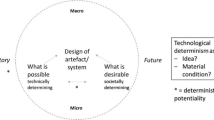Abstract
There is a widespread recognition of the desirability of broadening the scope of technology education with the objective of a form of ‘technological literacy’ which would embrace social relations as well as technique. In 1990, Technology was introduced as a compulsory element of general education in England and Wales. Initially the curriculum gave equal weight both to the context as well as the content of technological activity, but subsequent revisions point the way back to an emphasis on technique and a narrower view of the role of the designer. In some respects, this simplifies the task of the technology teacher, and it might also be said to reflect the everyday realities of much technological activity. It is, however, an essentially conservative approach which tends to reinforce and legitimise attitudes which place a high value on technical performance while consigning the purposes and outcomes of technological activity to the shadows. It is argued that, for the sake of the future, it is essential that values in design and technology are ‘brought up to the light’. Technology teachers should take some responsibility for this, but cannot be expected to shoulder the whole burden.
Similar content being viewed by others
References
Medway, P.: 1989, ‘Issues in the Theory and Practice of Technology Education’,Studies in Science Education 1, 1–24.
DES/WO: 1990,Technology in the National Curriculum, HMSO, London.
Smithers, A. and Robinson, P.: 1992,National Curriculum Technology: Getting it Right, Engineering Council, London.
WOCATE: 1993,Newsletter 1(1).
DES: 1988,National Curriculum Design and Technology Working Group: Interim Report, Department of Education and Science, London.
Mathews, J., Hall, G. & Smith, H.: 1988, ‘Towards Flexible Skill Formation and Technological Literacy: Challenges Facing the Education System’,Economic and Industrial Democracy 9(4), 497–522.
Budgett-Meakin, C. (ed.): 1992,Make the Future Work, Longman, London.
Mumford, L.: 1934,Technics and Civilization, Harcourt Brace, New York.
Layton, D.: 1992, ‘Values in Design and Technology’, in: Budgett-Meakin C. (ed.),Making the Future Work 3, Longman, London.
Shephard, T.: 1989,Introducing Design, Hutchinson, London.
Mulberg, C.: 1992, ‘Beyond the Looking Glass: Technological Myths in Education’, in: Budgett-Meakin C. (ed.),Make the Future Work 2, Longman, London.
DFE/WO: 1992,Technology for Ages 5 to 16, Department for Education.
Ditchfield, C. & Stewart, D.: 1987, ‘Technology and Science in the Curriculum; Some Issues and Ideas’,Secondary Science Curriculum Review, London.
Layton, D.: 1988, ‘Revaluing the T in STS’,Int. Journal of Science Education 10, 367–378.
Winner, L.: 1992,Autonomous Technology, MIT Press.
Noble, D. F.: 1979,America by Design, Oxford.
Author information
Authors and Affiliations
Rights and permissions
About this article
Cite this article
Barnett, M. Designing the future? Technology, values and choice. Int J Technol Des Educ 4, 51–63 (1994). https://doi.org/10.1007/BF01197583
Issue Date:
DOI: https://doi.org/10.1007/BF01197583




